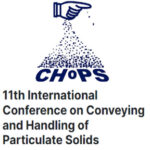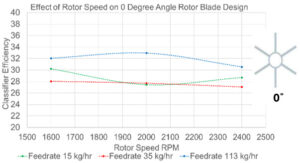 Zaki Hussaini, MEng, Design Engineer at Bradley Pulverizer recently presented “Ultrafine Air-Classification of Plant based Proteins: A Step Towards Reducing Carbon Footprints” at the 2024 International Conference on Conveying and Handling of Particulate Solids (CHoPS) in Edinburgh, Scotland. The research is being conducted in partnership with The Wolfson Center for Bulk Solids Handling Technology along with the engineering team at Bradley Pulverizer.
Zaki Hussaini, MEng, Design Engineer at Bradley Pulverizer recently presented “Ultrafine Air-Classification of Plant based Proteins: A Step Towards Reducing Carbon Footprints” at the 2024 International Conference on Conveying and Handling of Particulate Solids (CHoPS) in Edinburgh, Scotland. The research is being conducted in partnership with The Wolfson Center for Bulk Solids Handling Technology along with the engineering team at Bradley Pulverizer.
Zaki presented the preliminary results of research he is conducting into ways to improve the efficiencies of dynamic air classifiers in processes where exponential increases in energy are currently required to meet particle size specifications. By reducing power consumption, both a lower overall carbon footprint is maintained along with the added benefit of higher product yields and profitability.
The following is background into the motivation behind this research along with preliminary results and future research plans.
PROBLEM: Dynamic air classifiers are proven to classify sub-10 micron size particles, but the process is inefficient in that it requires high levels of regrinding, which requires longer running times and higher levels of power (energy consumption) to support. This raises both the cost of processing as well as the overall carbon footprint of the facility.
 PROCESS: Bradley Pulverizer is investing into research to determine and chart the effects that adjustments to air classifier operational and structural parameters have on processing yields and energy consumption.
PROCESS: Bradley Pulverizer is investing into research to determine and chart the effects that adjustments to air classifier operational and structural parameters have on processing yields and energy consumption.
All testing has been performed in a Bradley Pulverizer lab-size stainless steel Windsifter air classifier. The medium being processed was pea powder, with the desired cut-size being sub-10 micron (small enough to separate protein from carbohydrates within the power).
 The standard Windsifter rotor configuration with 0° rotor blade angles was used in the initial processing with multiple data points collected and charted to measure a baseline classifier efficiency. The tests were then repeated with variations in operational parameters such as feed rate and rotor speed with efficiency results charted accordingly. Variations in structural parameters such as adjustments in the angle of the rotor blades to 30° and 45° were then tested with results being charted against those from the baseline tests. Future testing is slated to test the effect of structural variations to guide vanes and distributor plates within the rotor cage as well as the effects from curved rotor blade, among others.
The standard Windsifter rotor configuration with 0° rotor blade angles was used in the initial processing with multiple data points collected and charted to measure a baseline classifier efficiency. The tests were then repeated with variations in operational parameters such as feed rate and rotor speed with efficiency results charted accordingly. Variations in structural parameters such as adjustments in the angle of the rotor blades to 30° and 45° were then tested with results being charted against those from the baseline tests. Future testing is slated to test the effect of structural variations to guide vanes and distributor plates within the rotor cage as well as the effects from curved rotor blade, among others.
 RESULTS: The data collected from this extensive research and testing has been analyzed and organized into baseline datasets representing expected performance results from various air classifier configurations. All data has been added to our master database of reference materials and is available as valuable information for our engineers to reference when engineering future projects.
RESULTS: The data collected from this extensive research and testing has been analyzed and organized into baseline datasets representing expected performance results from various air classifier configurations. All data has been added to our master database of reference materials and is available as valuable information for our engineers to reference when engineering future projects.
On a daily basis, virtually every opportunity presented to us requires some level of machine customization to meet the specifications required by the client. Bradley Pulverizer’s investment into testing the effects that variable parameters have on the overall yield and energy consumption of air classifiers is a testament to our dedication to advancing technical innovations within the materials processing industries.
Contact Us with your classification energy efficiency issues and we will work with you on the right solution.
